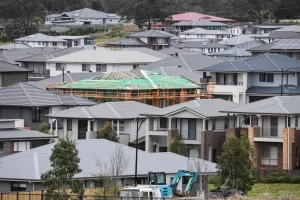New home loans for owner-occupier buyers fell to their lowest level in two years in September as rising rates and cost of living pressures hit people’s ability to borrow to buy housing.
Monthly new home loan commitments for owner occupiers dropped 9.3 per cent – the biggest month-on-month decline in at least two decades – to a seasonally adjusted $16.8 billion, the lowest total since August 2020, Australian Bureau of Statistics figures on Wednesday showed.
First home buyer mortgage commitments fell 6.8 per cent in value from August to $4.1 billion, the lowest since June 2020, while new investor borrowing fell 6 per cent to $8.3 billion, the weakest level in a year.
These latest figures are for September, when the Reserve Bank of Australia made the fifth consecutive move in interest. On Tuesday, the RBA lifted rates for the seventh month to hit 2.85 per cent.
The lag between rate decisions and higher mortgage payments – which RBA governor Philip Lowe mentioned on Tuesday – means that home loans will decline further.
So too, will dwelling prices.
“The deterioration in credit availability will continue which will drag on the demand for new and existing housing to mid-2023,” BIS Oxford Economics senior economist Maree Kilroy said.
“We ultimately expect a nationwide all-dwelling median price peak-to-trough fall of 11.5 per cent.”
Dwelling values dropped fastest in Brisbane of any capital city last month, shedding 2 per cent as the Queensland capital played catch-up to the declines already underway in the larger cities of Sydney and Melbourne, CoreLogic figures earlier this week showed.
Separate figures from SQM Research on Tuesday showed the number of distressed listings nationwide jumped by more than 15 per cent since May.
Queensland posted the biggest increase, up by 588 homes, or 26.7 per cent, to 2791, SQM said. In NSW, distressed listings jumped by 353 homes, or 38.7 per cent, to 1265, while Victoria added 99 distressed properties or 14.9 per cent to 765.
Distressed listings rose by 14 properties in Tasmania, three in the ACT and one in SA. WA and NT both recorded a drop in the number of distressed listings by 130 and two properties respectively.
New dwellings approvals
Separate ABS figures on Wednesday showed a decline in new dwelling approvals – a leading indicator of activity – and rising rates and weaker housing prices are likely to pull these numbers lower still.
Total new dwelling approvals fell 5.8 per cent in September from August, while detached houses declined 7.5 per cent and attached dwellings – apartments, townhouses and semi-detached homes – fell 3.1 per cent.
Monthly figures can be volatile, but even the longer-run year-on-year numbers showed the pace of decline was accelerating.
Over the year to September, new dwelling approvals totalled 193,332, down 16.6 per cent on the same month a year earlier. In May, the month of the first RBA rate increase, the year-on-year decline in housing approvals was just 4.2 per cent.
“Higher mortgage rates and falling dwelling prices are negatively associated with approvals, so continued monetary policy tightening (and lagged effects of delivered hikes) leave scope for further declines toward 2019 levels,” said JPMorgan economist Jack Stinson.
But there are also pressures working to strengthen demand, Mr Stinson said.
“Over the medium term, stronger population growth, with increased in inbound migration, will push against these headwinds,” he said.
Ms Kilroy was more pessimistic, saying that while detached home approvals would hold steady for the rest of this year, they would weaken next year.
“Beyond the sizeable backlog of work already committed, the outlook darkens medium term,” she said. “It has become increasingly difficult for new projects to gain traction, which will drag on approval volumes in 2023.”
Rising costs and falling prices would increasingly make proposed projects unviable for developers and similar concerns were affecting buyers, Ms Kilroy said.
“For potential new home buyers, rising interest rates are providing a growing drag on demand,” she said.
“Long wait times and the increased potential for cost overruns are also weighing on buyer confidence.”
This article is from Australian Financial Review, please click the following link for the original article: https://www.afr.com/property/residential/new-home-loan-commitments-hit-two-year-low-20221031-p5buf5




